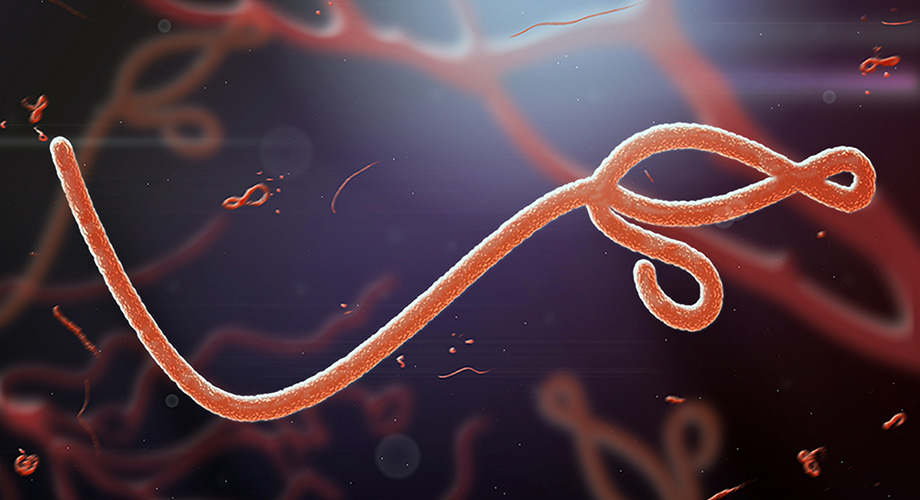
Two-antibody cocktail provides broad protection against ebolaviruses
Structural analysis shows how the antibodies work in a powerful synergy against the three major ebolavirus species.
November 17, 2021
LA JOLLA, CA—A combination of two highly potent antibodies, first discovered in the blood of ebolavirus survivors, protects monkeys against the three most medically important ebolavirus species, according to a new study from scientists at Vanderbilt University Medical Center (VUMC), Scripps Research, and Galveston National Laboratory. The antibody “cocktail” is the first to provide such broad protection, and potentially will be a powerful weapon against future ebolavirus outbreaks.
In the study, published October 28 in Cell, the scientists conducted extensive preclinical tests of the antibody cocktail, showing its effectiveness against not only the best-known ebolavirus species, Zaire ebolavirus (EBOV)—sometimes called Ebola virus—but also Sudan ebolavirus (SUDV) and Bundibugyo ebolavirus (BDBV). The three ebolaviruses in recent decades have caused frequent hemorrhagic fever outbreaks in Africa, killing tens of thousands of people.
The researchers used low-temperature electron microscopy (cryo-EM) to map the structures of the antibodies bound to their target sites on ebolaviruses, showing how they work in complementary ways to neutralize these pathogens.
“The synergy between these two antibodies is really unique and adds up to broader protection than any other antibody or combination has shown so far,” said study co-lead author Charles Murin, PhD, a staff scientist at Scripps Research.
Murin led the structural analysis, sharing co-lead authorship with Pavlo Gilchuk, PhD, a postdoctoral research associate at Vanderbilt. Murin works in the laboratory of study co-author Andrew Ward, PhD, professor in the Department of Integrative Structural and Computational Biology at Scripps Research. The study’s lead investigator was James Crowe Jr., MD, professor of Pediatrics and Pathology, Microbiology and Immunology at VUMC, and director of the Vanderbilt Vaccine Center.
The high lethality of ebolaviruses and their potential for rapid spread has driven efforts to find effective vaccines and treatments, including antibody-based therapies that could be given, for example, to provide immediate, short-term protection for people who have been exposed to these viruses. However, the antibody therapies and vaccines that have been developed to date provide protection only against EBOV.
The remarkable antibodies described in the new study, rEBOV-442 and rEBOV-515, were derived from antibody-making B cells that researchers recovered from the blood of two survivors of African EBOV outbreaks during 2013 to 2016.
The researchers conducted a battery of tests showing that the two antibodies have neutralization activity against not only EBOV but also SUDV and BDBV, draw immune cells to kill ebolavirus-infected cells in two distinct ways, and, when combined in a therapeutic cocktail, enhance each other’s efficacy to provide very potent neutralization of all three viral species. The experiments showed that ebolaviruses subjected to the 442/515 cocktail also were much less likely to evolve “escape mutants” compared to other antibody combinations.
The researchers injected macaque and cynomolgus monkeys with lethal doses of EBOV, SUDV, and BDBV, and then injected them with two doses of the antibody cocktail starting on day 3 to 6 after the viral exposure. The cocktail protected the monkeys not only from death but also from signs of disease—even from abnormal blood-test results. By contrast, monkeys who were given the virus but not the antibody cocktail succumbed in 7 to 14 days.
Murin’s cryo-EM-based structural studies supported the protection trials by revealing the two distinct locations where the antibodies bind to the ebolavirus outer glycoprotein. His results confirmed that the -515 antibody in particular binds to a small site that is uniquely well conserved among the EBOV, SUDV, and BDBV species.
“That structural information was really valuable in understanding why these antibodies work so well and so broadly when combined,” Murin says.
The very promising results are the apparent culmination of years of work toward the discovery of such a potent, broad-acting antibody cocktail, and set the stage for scaled-up production of the antibodies, and experimental trials in humans during future ebolavirus outbreaks.
“Pan-ebolavirus protective therapy by two multifunctional human antibodies” was co-authored by Pavlo Gilchuk, Seth Zost, Rachel Nargi, Rachel E. Sutton, Naveenchandra Suryadevara, Robin Bombardi, Robert Carnahan, and James Crowe, Jr., of the Vanderbilt Vaccine Center; Charles Murin and Andrew Ward of Scripps Research; and Robert Cross, Philipp Ilinykh, Kai Huang, Natalia Kuzmina, Viktoriya Borisevich, Krystle Agans, Joan Geisbert, Alexander Bukreyev, and Thomas Geisbert of the Galveston National Laboratory.
The research was supported by the National Institutes of Health (U19 AI109711, U19 AI142785, U19 AI109762), the U.S. Department of Health and Human Services (HHSN272201400058C), the U.S. Defense Threat Reduction Agency (HDTRA1-13-1-0034), and Merck KGaA.
For more information, contact press@scripps.edu

